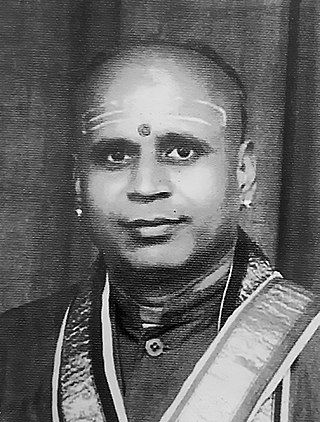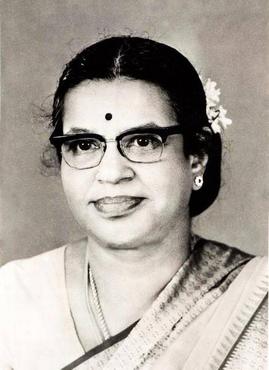
Carnatic music, known as Karnāṭaka saṃgīta or Karnāṭaka saṅgītam in the South Indian languages, is a system of music commonly associated with South India, including the modern Indian states of Karnataka, Andhra Pradesh, Telangana, Kerala and Tamil Nadu. It is one of two main subgenres of Indian classical music that evolved from ancient Hindu texts and traditions, particularly the Samaveda. The other subgenre being Hindustani music, which emerged as a distinct form because of Persian or Islamic influences from Northern India. The main emphasis in Carnatic music is on vocal music; most compositions are written to be sung, and even when played on instruments, they are meant to be performed in gāyaki (singing) style.

Thyagaraja, also known as Thyāgayya and in full as Kakarla Thyagabrahmam, was a composer and vocalist of Carnatic music, a form of Indian classical music. Tyagaraja and his contemporaries, Shyama Shastri and Muthuswami Dikshitar, are regarded as the Trinity of Carnatic music. Tyagaraja composed thousands of devotional compositions, most in Telugu and in praise of Rama, many of which remain popular today, the most popular being "Nagumomu". Of special mention are five of his compositions called the Pancharatna Kritis, which are often sung in programs in his honour, and Utsava Sampradaya Krithis, which are often sung to accompany temple rituals.

The Pancharatna kritis are a set of five kritis (songs) in Carnatic classical music, composed by the 18th-century Indian composer Tyagaraja. All the kritis, as is the case with almost all of Tyagaraja's compositions, are penned in Telugu, except the first one, which is composed in Sanskrit. The songs are: "Jagadananda karaka", "Dudukugala Nanne", "Sadhinchene", "Kanakana Ruchira" and "Endaro Mahanubhavulu".

Muthuswami Dikshitar (Mudduswamy Dikshitar)(IAST: muttusvāmi dīkṣitar, 24 March 1776 – 21 October 1835), mononymously Dikshitar, was a South Indian poet, singer and veena player, and a legendary composer of Indian classical music, who is considered one of the musical trinity of Carnatic music. Muthuswami Dikshitar was born on 24 March 1775 in Tiruvarur near Thanjavur, in what is now the state of Tamil Nadu in India, to a family that is traditionally traced back to Virinichipuram in the northern boundaries of the state. His compositions, of which around 500 are commonly known, are noted for their elaborate and poetic descriptions of Hindu gods and temples and for capturing the essence of the raga forms through the vainika (veena) style that emphasises gamakas. They are typically in a slower speed (chowka kala). He is also known by his signature name of Guruguha which is also his mudra (and can be found in each of his songs). His compositions are widely sung and played in classical concerts of Carnatic music.

Syama Sastri or Shyama Shastri was a musician and composer of Carnatic music. He was the oldest among the Trinity of Carnatic music, Tyagaraja and Muthuswami Dikshitar being the other two.

Harikesanallur Muthiah Bhagavatar, commonly known as Muthiah Bhagavatar, is one of Carnatic classical music's famous twentieth-century composers. He also created about 20 ragas.

Anandabhairavi or Ananda Bhairavi is a very old melodious rāgam of Carnatic music. This rāgam also used in Indian traditional and regional musics. Ānandam (Sanskrit) means happiness and the rāgam brings a happy mood to the listener.
Veena Kuppayyar (1798–1860) was an exponent of Veena and a composer of Carnatic music. He was a student of the famous composer Tyagaraja. Kuppayar composed his songs in Telugu language and has left behind a number of popular kritis.

Mysore Vasudevacharya was an Indian musician and composer of Carnatic music compositions who belonged to the direct line of Thyagaraja's disciples. Vasudevachar's compositions were mostly in Telugu and Sanskrit. Some of his most popular kritis include Broche varevaru ra in Khamas raga, Devadideva in Sunadavinodini, Mamavatu Sri Saraswati in Hindolam, Shankari Ninne in Pantuvarali, Bhajare Re Manasa in Abheri and Ra Ra Rajeevalochana Rama in Mohanam. He was a recipient of the civilian honour of the Padma Bhushan.
The Trinity of Carnatic Music, also known as the Three Jewels of Carnatic Music, refers to the outstanding trio of composer-musicians of Carnatic music in the 18th century—Tyagaraja, Muthuswami Dikshitar, and Syama Sastri. Prolific in composition, the Trinity of Carnatic music is known for creating a new era in the history of carnatic music by bringing about a noticeable change in what was the existing carnatic music tradition. Compositions of the Trinity of Carnatic music are recognized as being distinct in style, and original in handling ragas. All three composers were born in Thiruvarur, formerly part of Thanjavur District in Tamilnadu. M. S. Subbalakshmi, D. K. Pattammal, and M. L. Vasanthakumari, who are carnatic musicians of the 20th century, are popularly referred to as the female Trinity of Carnatic Music.

The Kingdom of Mysore (1399–1950) was founded by Yaduraya in 1399 as a feudatory of the Vijayanagara Empire and became an independent kingdom in the early 17th century, after the decline of the Vijayanagara Empire. Many musicians and composers have presumably adorned the courts of the Mysore kings from Yaduraya's time, furthering the Dakshinadi school of music that had developed in earlier centuries. However, records are only available from the time of King Ranadheera Kanteerava Narasaraja Wodeyar (1638). Musical treatises surviving from this time, though, provide ample information on the music, musical instruments, the types of compositions, the raga (melodies) and the tala (rhythms) used. Though all the Mysore kings patronised music, the golden age of Carnatic music was considered to be during the reigns of Kings Krishnaraja Wodeyar III (1794–1868), Chamaraja Wodeyar IX (1862–1894), Krishnaraja Wodeyar IV (1884–1940) and Jaya Chamaraja Wodeyar (1919–1974). The reign of Krishnaraja Wodeyar IV is regarded as particularly important in musical terms.

Madhyamavati (madhyamāvati) is a rāga in Carnatic music. It is an audava rāga, as it does not have all the seven musical notes (swaras). It is a janya rāga. The equivalent of Madhyamavati in Hindustani music is Madhumad Sarang. It also has other equivalents in Hindustani music such as ragas Megh and Megh Malhar.

Mayuram Viswanatha Sastri (1893–1958) was a Carnatic music composer. His most remembered composition is the patriotic song "Jayathi Jayathi Bharata Mata". Translated "Victory Victory to Mother India", the song has become a standard among classical singers of South India. This song is one of the 18 songs in his book 'Bharat Bhajan' which was published in the year 1948 containing songs in praise of Bharat Matha and Mahatma Gandhi. This book was one among his many publications. See AIR's 13-episode documentary of his works.

Shri ragam is an ancient ragam in the Carnatic tradition. It is also written as Sri or Shree. This scale does not have all the seven swaras in the ascending scale. Shree is the asampurna melakartha equivalent of Kharaharapriya, the 22nd Melakarta rāgam. It is the last of the 5 Ghana rāgams of Carnatic music. It is a popular rāgam that is considered to be highly auspicious.

Rallapalli Ananta Krishna Sharma was a noted composer of Carnatic music, singer, Telugu litterateur, teacher and Sanskrit scholar. He was responsible for discovering, cataloguing and putting to music many forgotten compositions of Annamacharya. These compositions composed hundreds of years ago came back to life thanks to Sharma's efforts and successive singers like S. P. Balasubramanyam and M. S. Subbalakshmi would sing many of them, hence popularising them. Sharma authored prose works like Vemana, Natakopanyasamulu,Ganakale,Sahitya Mattu Jeevana Kale and Saraswatalokamu. Rallapalli Ananta Krishna Sharma translated 395 Gathas from original Prakrit into Telugu language titled Shalivahana Gatha Sapta Saramu in 1931. Sharma is the recipient of Central Sangeet & Natak Academy Fellowship (1973), Gana Kala Sindhu (1961), Gana Kala Prapoorna (1969), Sangeeta Kala Ratna (1974) and Sangeeta Sahitya Asthan Vidwan honours with a Honorary Doctorate from TTD University, Andhra Pradesh.

Navarasa kannada or Navarasakannada is a rāgam in Carnatic music. It is a janya rāgam from the 28th melakarta scale Harikambhoji. This scale is well suited for instrumental music, especially with veena and flute. It is suited for orchestral music as well.

"Vatapi Ganapatim", also known as "Vatapi ganapatim bhajeham" or "Vatapi ganapatim bhaje", is a Sanskrit kriti song by the South Indian poet-composer Muthuswami Dikshitar (1775–1835), one of the "Trinity of Carnatic music". The panegyrical hymn praises Vatapi Ganapati, Ganesha (Ganapati) worshipped in a shrine in Tiruchenkattankudi Utrapatishwaraswamy Temple dedicated to lord Shiva in Thiruvarur district in the Tamil Nadu state of India. The hymn is composed in Hamsadhvani raga ; however, in tradition of kritis, individual performers add their own variations in the tune as a part of improvisation. Vatapi Ganapatim is considered the best-known piece of Muthuswami Dikshitar and is one of the most popular compositions of Carnatic music. The hymn is traditionally sung at the beginning of many Carnatic music concerts.

Ambujam Krishna was a composer of Carnatic Kritis. She has composed more than 600 kritis in various Carnatic ragas.









